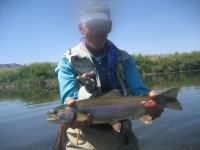wbranch
Well-known member
While I am by no means a novice when it comes to fly fishing I have zero knowledge about Euro nymphing. I've heard so much about it and how effective it is I figured if I learned the skills and techniques required I could learn something new and increase my catch rate.
I feel I am a good student and have light line rods but none longer than 9'. I'm willing to buy whatever lines or leaders are needed and will tie whatever flies are recommended. I just ordered those 60 degree jig hooks in #12, 14, and 16 and four different colors and sizes of slotted tungsten beads.
The only limiting factor is I hate the cold weather and wouldn't want to actually fish until the air temperature at least 52 degrees.
I feel I am a good student and have light line rods but none longer than 9'. I'm willing to buy whatever lines or leaders are needed and will tie whatever flies are recommended. I just ordered those 60 degree jig hooks in #12, 14, and 16 and four different colors and sizes of slotted tungsten beads.
The only limiting factor is I hate the cold weather and wouldn't want to actually fish until the air temperature at least 52 degrees.




